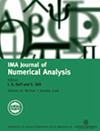A backward differential deep learning-based algorithm for solving high-dimensional nonlinear backward stochastic differential equations
IF 2.4
2区 数学
Q1 MATHEMATICS, APPLIED
引用次数: 0
Abstract
In this work we propose a novel backward differential deep learning-based algorithm for solving high-dimensional nonlinear backward stochastic differential equations (BSDEs), where the deep neural network (DNN) models are trained, not only on the inputs and labels, but also on the differentials of the corresponding labels. This is motivated by the fact that differential deep learning can provide an efficient approximation of the labels and their derivatives with respect to inputs. The BSDEs are reformulated as differential deep learning problems by using Malliavin calculus. The Malliavin derivatives of the BSDE solution themselves satisfy another BSDE, resulting thus in a system of BSDEs. Such formulation requires the estimation of the solution, its gradient and the Hessian matrix, represented by the triple of processes $\left (Y, Z, \varGamma \right ).$ All the integrals within this system are discretized by using the Euler–Maruyama method. Subsequently, DNNs are employed to approximate the triple of these unknown processes. The DNN parameters are backwardly optimized at each time step by minimizing a differential learning type loss function, which is defined as a weighted sum of the dynamics of the discretized BSDE system, with the first term providing the dynamics of the process $Y$ and the other the process $Z$. An error analysis is carried out to show the convergence of the proposed algorithm. Various numerical experiments of up to $50$ dimensions are provided to demonstrate the high efficiency. Both theoretically and numerically, it is demonstrated that our proposed scheme is more efficient in terms of computation time or accuracy compared with other contemporary deep learning-based methodologies.一种求解高维非线性后向随机微分方程的后向微分深度学习算法
在这项工作中,我们提出了一种新的基于后向微分深度学习的算法来求解高维非线性后向随机微分方程(BSDEs),其中深度神经网络(DNN)模型不仅在输入和标签上进行训练,而且在相应标签的微分上进行训练。这是因为微分深度学习可以提供标签及其导数相对于输入的有效近似值。利用Malliavin微积分将BSDEs重新表述为微分深度学习问题。BSDE解的Malliavin导数本身满足另一个BSDE,从而产生一个BSDE系统。这样的公式需要估计解,它的梯度和Hessian矩阵,由过程$\left (Y, Z, \varGamma \right)的三重表示。用欧拉-丸山法将系统内的所有积分离散化。随后,dnn被用来近似这些未知过程的三倍。通过最小化微分学习型损失函数,在每个时间步上向后优化DNN参数,该损失函数被定义为离散BSDE系统动态的加权和,其中第一项提供过程Y的动态,另一项提供过程Z的动态。通过误差分析证明了该算法的收敛性。提供了高达50美元尺寸的各种数值实验来证明其高效率。从理论上和数值上都证明,与其他基于深度学习的方法相比,我们提出的方案在计算时间或精度方面更有效。
本文章由计算机程序翻译,如有差异,请以英文原文为准。
求助全文
约1分钟内获得全文
求助全文
来源期刊
CiteScore
5.30
自引率
4.80%
发文量
79
审稿时长
6-12 weeks
期刊介绍:
The IMA Journal of Numerical Analysis (IMAJNA) publishes original contributions to all fields of numerical analysis; articles will be accepted which treat the theory, development or use of practical algorithms and interactions between these aspects. Occasional survey articles are also published.

 求助内容:
求助内容: 应助结果提醒方式:
应助结果提醒方式:


